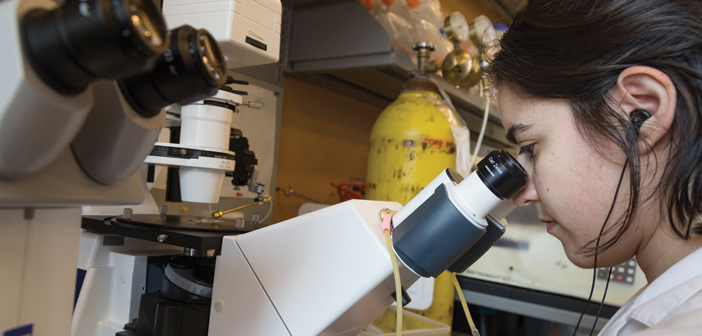A foundation gift provides a boost for ALS research.
Amyotrophic lateral sclerosis, also known as Lou Gehrig’s disease, remains one of the great medical mysteries. The neurodegenerative disease causes progressive deterioration of motor neurons, leaving those affected unable to speak, eat, move, and breathe. There is no cure, nor treatment to slow it.
Meeting those challenges requires innovative approaches that capitalize on expertise from disparate fields. A new $1.8 million grant from the ALS Finding a Cure Foundation has coalesced a team at Brown to do just that. The grant “is important seed funding for innovative ideas and collaborations that wouldn’t have happened” otherwise, says Diane Lipscombe, PhD P’14, interim executive director of the Brown Institute for Brain Science and professor of neuroscience. Merit Cudkowicz, MD, chief medical officer of the ALS Finding a Cure Foundation and chief of neurology at Massachusetts General Hospital, says the Brown-led effort could be key to the organization’s goal. “It’s exciting because it brings together many different labs,” she says.
ALS “is a problem that has resisted the standard approaches,” Lipscombe says. The new effort will span several species—worms, fruit flies, mice, and human induced pluripotent cells—and look for common triggers and suppressors of the disorder. The Brown team, which includes five principal investigators, will work with two more PIs and others at Mass General and the University of Massachusetts Medical School, including Robert J. Brown, MD, DPhil, one of the world’s foremost ALS researchers. Among the goals are to understand why and how certain neurons lose function and die; to identify genes that will slow or stop the disease; and to pinpoint early events that could be used to prevent disease progression.
This multi-institutional, multi-species approach holds promise for developing new models of ALS, Cudkowicz says, and for replicating features of the human disease and doing important work in identifying suppressors.
The ALS Finding a Cure funding is expected to be for three years, with additional dollars coming in each subsequent year if the team shows progress. The grant will offer opportunities to “talented young scientists at all levels,” Lipscombe says, with funding to hire undergraduate, graduate, and medical students, as well as postdoctoral students.
“The foundation money changes what we can do,” says Anne Hart, PhD, a principal investigator at Brown and professor of neuroscience. One of Brown’s greatest advantages is the collaboration for which the University is known. She adds, “People talk to each other and collaborate at Brown at a level you don’t see many places.”
Brown’s ALS work and successful grant proposal to the ALS Finding a Cure foundation incubated for several years with the aid of other important support, including the Istanbul-based Suna and Inan Kiraç Foundation, the DEARS Foundation, and Biogen.
Last summer the Rhode Island chapter of the ALS Association conferred its highest honor, the Spirit of Lou Gehrig Award, on researchers at Brown for their work so far. Lipscombe says the team was moved and inspired by meeting many patients with ALS and their families. “This is an incredible responsibility,” she says. “This is a race against time.”




